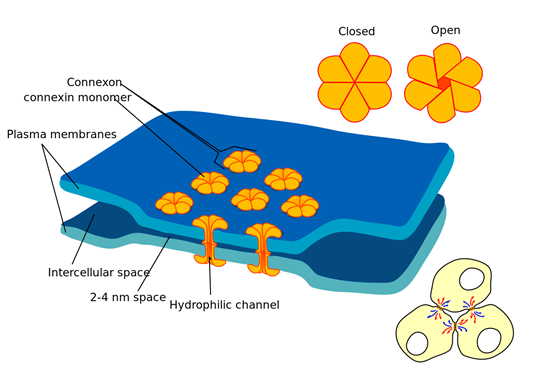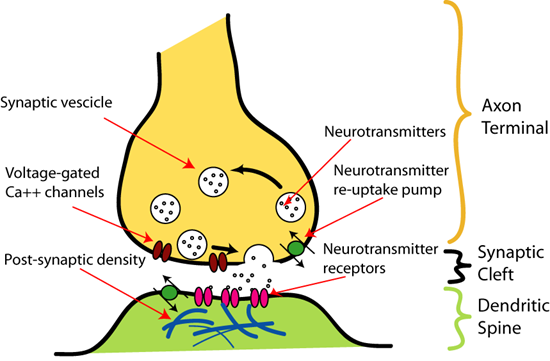Electrical and Chemical Synapse
The difference between electrical and chemical synapses can only be understood by explaining the structure of synapses, the synaptic delay and the function of synapse. Synapse is the junction between two nerves cells that have gap in between from where the impulses transmit to reach the destination. It can also be said that it is the site of communication between two neurons or the neuron and effectors cell. This transfer of impulse is done by the process of diffusion for effective working of the nerve cells. Synapses are important because they help in the filtration of information. Above all, any problem in the synaptic communication can results in many diseases. The transmission of impulses from one neuron to the other takes place due to synapses. But at the same point, receiving neurons and transmitting neuron are differently named so as to distinguish them on the basis of communication. Therefore, the neurons that send the signals are called presynaptic neuron and the neurons that receive the signals are called postsynaptic neuron.
Difference between Electrical and Chemical Synapse
Synapses are divided into two main types of synapses called electric synapse and chemical synapse.
Electrical synapse

The conduction of impulses through the gap junction is done at electrical synapses; this process is accomplished by the connexons (connexons are ion conduits that join two neighboring cells) that are present in gap junction. (The other name for electrical synapses is in fact gap junctions.) These connexons helps to connect cytosol of two different cells that results in exchange of ions and hence, spreading the action potential. Beside this, there are two main advantages of electrical synapses:
- The conduction of synapses through electrical medium is faster and direct than that of chemical synapses.
- The electrical synapse is conducted by thousands of neurons and these neurons works together so as to bring out the needed result.
- The flow of information across gap junctions is bi-directional. This sometime allows for even faster information exchange as neurons can effectively behave as Meganeurons.
The electric synapse are most commonly found in smooth and cardiac muscles.
Chemical synapse

This is another type of synapse that works on the chemical methods. In this case, the plasma membrane of both the neurons, i.e. presynaptic and postsynaptic nerves lies side by side. Still, one noticeable thing is that they are not connected to each other. The point of their separation is called synaptic cleft which is filled with a fluid called interstitial fluid. When a stimulus is received by a presynaptic neuron, voltage gated ca2+ channel opens. The concentration of calcium ion is more towards the extracellular fluid rather than the inner of the membrane; hence inflow of calcium ion through this channel takes place which is a depolarizing phase. This increase in concentration of the calcium ions results in exocytosis. Here, exocytosis of the synaptic vesicle takes place and hence results in release of neurotransmitter. Therefore, electrical signal is converted to chemical signal. This chemical thus released by the presynaptic neuron, diffuse in the interstitial fluid and finally binds the receptor located in the plasma membrane of receiving neuron called postsynaptic neuron. At this point, ligand- gated channel is set up by the binding of neurotransmitter molecule to the receptor. This binding allows the inflow of ions across the membrane. Now, these postsynaptic neuron coverts this chemical signals to the electrical signal called postsynaptic potential, which is a gradient potential. In fact, postsynaptic potential can also be defined as the change in membrane potential. Finally, when threshold is established, action potential is generated in the axon of post- synaptic neuron. Therefore, in this overall process little time is wasted in transfer of signal and it is the reason that this synapse is little slower than chemical synapse.
It must be noted that it is only the synaptic end bulb that release the neurotransmitter and the generated action potential will only travel in one direction i.e. forward direction. The other important point is that, only the postsynaptic neurons membrane has the receptor protein that recognizes the particular neurotransmitter.
Synaptic Delay
Synaptic delay is defined as the time elapsed between peak of inward current through (arrival of nerve impulse at) the presynaptic membrane and commencement of inward current through the postsynaptic membrane (start of postsynaptic potential). In simple words synaptic delay refers to the amount of time taken to conduct a neuro-signal across synapse. Such a delay is almost absent in electrical synapse. In chemical synapse a synaptic delay of around 0.3 to 0.5 milliseconds or even more is known to occur.
Are most synapses electrical or chemical?
Most mammalian synapses are chemical synapse. There was much debate on whether the neuro-transmissions are actually chemical or electrical in nature. Electrical synapses were first demonstrated only in late 1950s in the escape-responsive neurons of a crayfish (and later in several other vetebrates). Electrical and Chemical synapse are also known to occur within the same terminals such as in Mauthner Cells. Overall, both this synapses are equally important for proper conduction of the impulse. Though among the two, electrical synapse travel faster, but recent studies have proved that chemical synapses has neuroplasticity that helps in the effective transfer of the information. Both these work in co- ordinate manner so as to give the better outcome.


